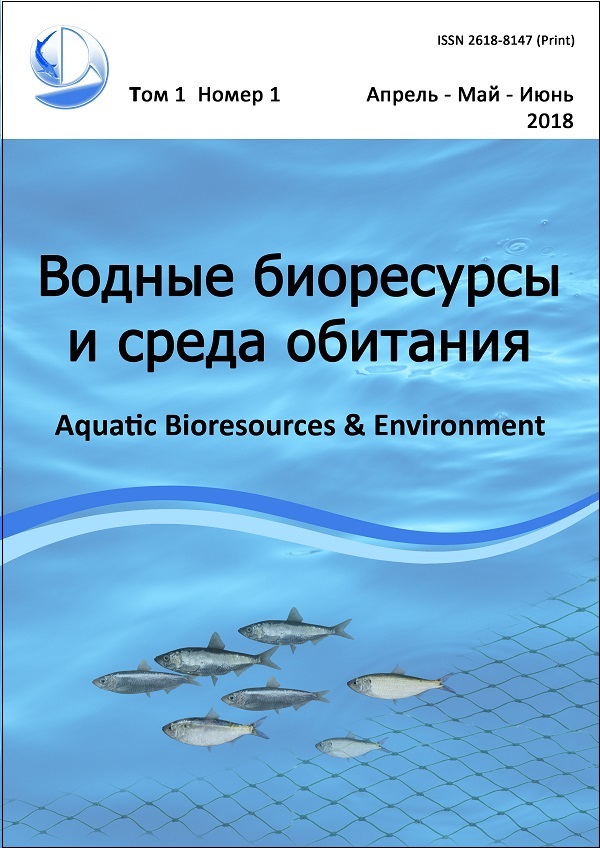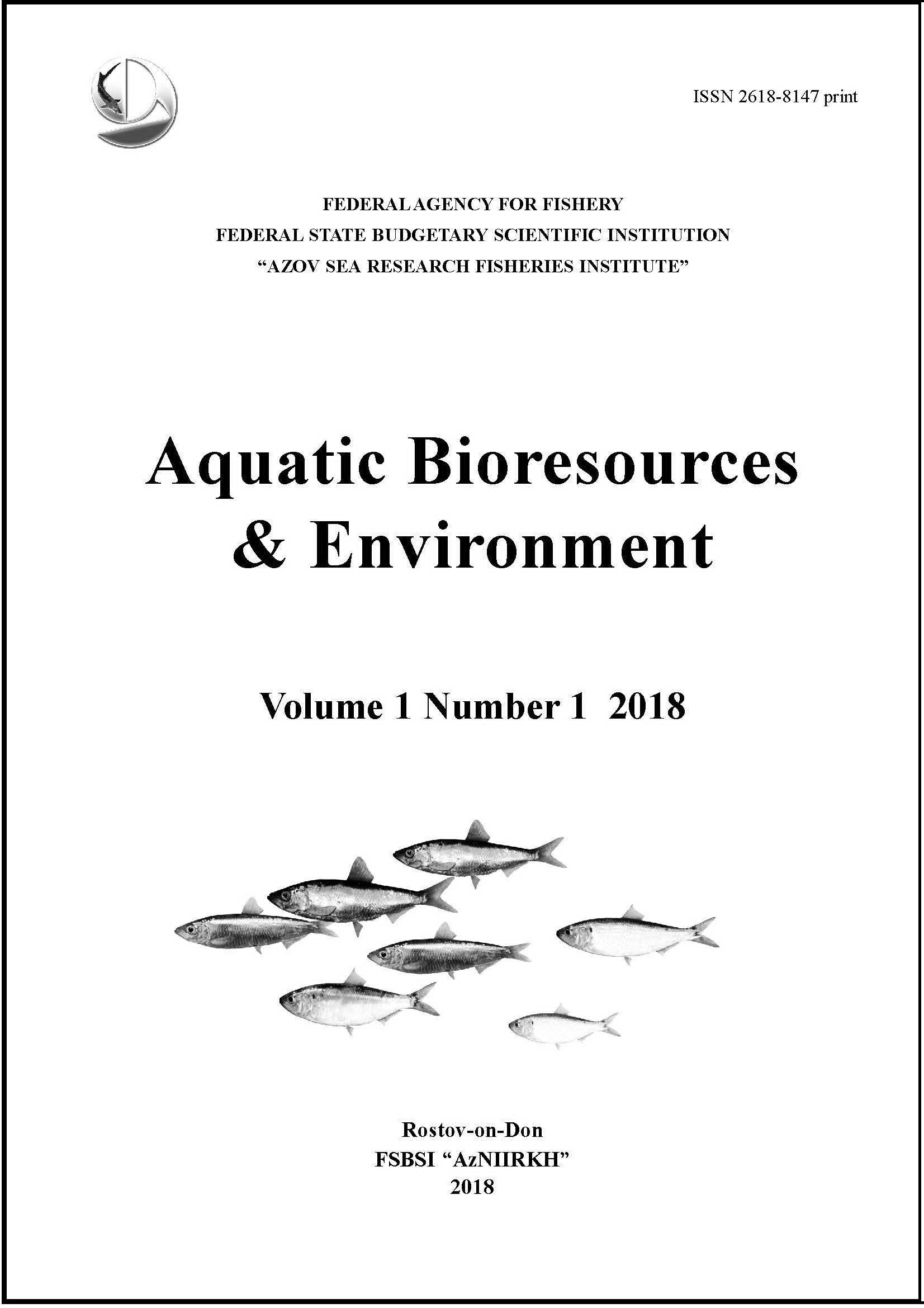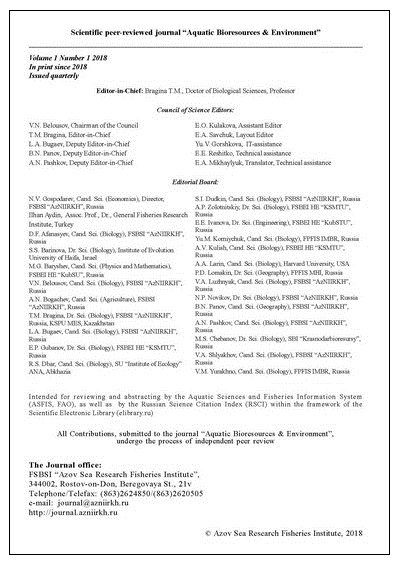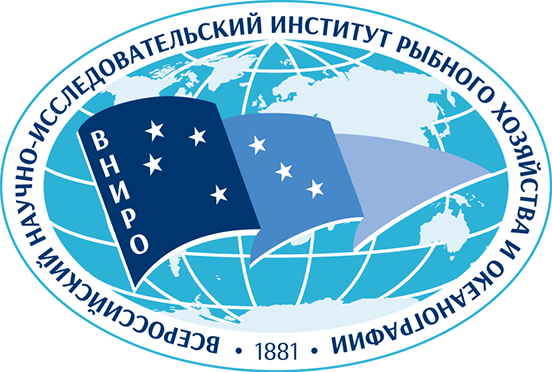Volume 1, Number 1
30-03-2018
Год / Year
2018
Aquatic Bioresources & Environment. Volume 1, Number 1, 2018



CONTENT
A welcome word from Nikolay Viktorovich Gospodarev, Director of the Federal State Budgetary Scientific Institution “Azov Sea Research Fisheries Institute”.
Dear readers and authors, revi ewers, members of Editorial Board and Editorial Council!
I am happy to congratulate you on the first issue of the scientific peer-reviewed journal “Aquatic Bioresources & Environment”, initiated under the auspices of the Federal State Budgetary Scientific Institution “Azov Sea Research Fisheries Institute” (FSBSI “AzNIIRKH”).
FSBSI “AzNIIRKH” is a basin institution of the Federal Agency for Fishery, carrying out multi- scale research in the Azov and Black Seas, as well as in the adjacent continental water bodies.
The research areas of the Institute include all the aspects of fisheries: studies on regularities of the biological resources stock dynamic s, envir o nment al mo nit or ing o f wat er bodies, aquaculture and mariculture technology, aquatic biological resources processing and design of fishing gear. All the research trends are investigated internationally, because both the Azov and Black Seas are water territories of interest for a number of states.
We are eager to combine the best practices and knowledge in the sphere of fisheries in order to solve various academic and applicable issues.
We hope the journal “Aquatic Bioresources & Environment” will encourage the spread of scientific knowledge, innovations, and fishery technologies, as well as sustainable promotion of the world's scientific heritage.
May I wish a long and fruitful way to all the readers and those in charge of edition of the new scientific peer-reviewed journal, which is initiated in the year of a very remarkable milestone date — the 90th anniversary of the Azov Sea Research Fisheries Institute!
Gospodarev N.V.
Review Articles
Fishery research of Russia in the Azov and Black Seas Basin (the 90th anniversary of the Federal State Budgetary Scientific Institution “Azov Sea Research Fisheries Institute”).
Belousov V.N., Bragina T.M., Bugaev L.A., Rekov Yu.I.
Abstract. The paper provides an overview of the principal trends of fishery research in the Azov and Black Seas Basin from the beginning of the first investigations to the modern complex scientific research of aquatic organisms and their habitats, development of innovative approaches in their sustainable use and conservation. Commencement of the ichthyofauna studies is associated with the expeditions of the late XIX and early XX centuries. The Rostov branch of the Don-Kuban Scientific Station, founded in 1928, became the str uctural unit, which combi ned the efforts of scientists in order to study the aquatic ecosystems in the region. In connection with this date the Azov Sea Research Fisheries Institute celebrates its 90th anniversary in 2018. In the early years, mainly resource investigations were conducted to provide the foodstuffs for the population . Comprehensive scien tific works were initiated with regard to the planned transformations of the Don River, including the constructi on of the Volga-Don Shipping Canal and the study of the possible impact of hydraulic structures on the ichthyofauna of the basin, as well as rapid development of the Azov and Black Seas and the Lower Don biological resources. The Institute was established in 1958 by the order of the Council of Ministers of the USSR on the basis of the All- Russian Scientific Research Institute of Fisheries and Oceanography (VNIRO). The main trends of fishery research in the Azov and Black Seas Basin currently include prediction of the state of aquatic biological res ources and development of recommendations for sustainable development of the fishery industry, as well as monit oring of the aquatic ecosystems status and aquaculture development in th e region.
Keywords: Azov and Black Seas Fishery Basin, aquatic biological resources, habitat, fishery research, fishery institutions
Environmental Concerns and the State of the Aquatic Environment
Current state of water quality and bottom sediments in Lake Donuzlav.
Zhugaylo S.S., Avdeeva T.M., Pugach M.N., Adzhiumerov E.N.
Abstract. Analysis of hydrochemical, chemical and toxicological features of water and bottom sediments in Lake Donuzlav (Crimea, Russia) according to the results of environmental monitorings conducted by the Kerch Branch of FSBSI “AzNIIRKH”, as well as according to the historical data collected by YugNIRO (Southern Scientific Research Institute of Fisheries and Oceanography) since 2000, is presented for the period from 2015 to 2017. Estimations of oxygen content in water, as well as BOD (biochemical oxygen demand) and the content of biogenic elements were made using standard practices, of heavy metals — using the method of atomic absorption spectrophotometry, of petroleum hydrocarbons – the method of infrared spectrophotometry. It is found out that the oxygen regimen of the southern Donuzlav L. was satisfactory for hydrobionts: the average annual contents of the dissolved oxygen varied within the range of 8.77–9.40 mg/l. It is shown that seasonal variations of the biogenic elements content are mainly predetermined by natural factors. In general, water aeration was good; however, the oxygen regimen was influenced by anthropogenic pressure, which resulted in relatively low dependency between oxygen saturation and water temperature. The long-term dynamics of the content of heavy metals and petroleum hydrocarbons in the water and bottom sediments of Lake Donuzlav is given. At present, the level of water pollution with heavy metals and petroleum hydrocarbons is rather low; however, there is a risk of aggravation of anthropogenic pressure impact on Lake Donuzlav ecosystem, which is evidenced by peak concentrations of some contaminants, observed in recent years. The increasing trend in mercury, copper and zinc content in the bottom sediments of the southern Lake Donuzlav is shown, as well as the decreasing trend in the content of iron, manganese, lead, chrome and petroleum hydrocarbons. The level of bottom sediments pollution in the central part of the lake is higher in comparison with its other areas, which is preconditioned by a higher sorption capacity of the bottom soil, containing high amount of fine particle fraction.
Keywords: Lake Donuzlav, Crimea, water quality, bottom sediments, oxygen regimen, biogenic elements, heavy metals, petroleum hydrocarbons
Biology and Ecology of Aquatic Organisms
The problem of integral assessment of toxic influence on photosynthetic organisms in aquatic ecosystems.
Barinova S.S.
Abstract. The article presents a methodical approach to the integral assessment of the toxic effect of variou s toxicants on photosensitive organisms. The toxic compounds, affecting aquatic organisms in general a nd the process of photosynthesis of proteins in particular, are characterized. Calculation of the new in dex WESI is based on the idea of residual concentrations of nitrogen and phosphorus nutrients in case of suppression of the photosynth etic process by toxic elements, namely, the activity of chlorophyll. Calculation of the in dex WESI is carried out using a simple formula based on the results of classification to the rank of concentrati ons of nitrate nitrogen or phosphates and saprobity indices S. A model for conducting an ecological classification from the ecosystem perspective for the purpose of calculating the index WESI is shown. Classification tables are presented for 9 ranks graded from the ecological point of view. A description of the ecosystem status index WESI that has been developed, a detailed pr ocedure for its calculation, and examples of its application to various water bodies of Eurasia are given. The way of application of the index WESI in monitor ing and environmental mappi ng is shown, as well as the criter ia for its change for the decision-making system when assessing the stat e of a water body and for preserving the diversity of aquatic organisms under conditions of toxic effects on primary producers.
Keywords: aquatic ecosystem, algae, ecological status index, toxicity
Invasion of the bivalve Corbicula fluminea (O.F. Müller, 1774) (Bivalvia: Cyrenidae) into the Lower Don Basin.
Zhivoglyadova L.A., Revkov N.K.
Abstract. The bivalve mollusk Corbicula fluminea (O.F. Müller, 1774), a recent invader into the basin of the Lower Don, was discovered in the Teplyj Canal (Warm Canal) of the Novocher kassk Hydroelectric Power Plant and in the adjacent stretch of the Don River in January 2017. The distribution of C. fluminea extended in the period from May to September of the same year; several live specimens of th is species were found downstream from the mouth of the Manych River. Considering high invasive potential of C. fluminea and possible environmental and economic consequences of its mass development, it is recommended to monitor further spreading of the mollusk th roughout the Don River system.
Keywords: alien species, Lower Don Basin, biological invasions, Bivalvia, Corbicula fluminea
Changes in species composition and abundance of ichthyoplankton in the Azov Sea and north-eastern Black Sea during 2006–2017 under conditions of natural and anthropogenic factors.
Nadolinskiy V.P., Nadolinskiy R.V.
Abstract. Variations in species and quantitative composition of ichthyoplankton in the Azov Sea and the Russian part of the Black Sea due to ch anges in the environ mental conditions ar e assessed. Th e ichthyoplan kt on investigations have been carried out in the Azov and Black Seas Basin for the last 50 years by means of an 80 cm mesh size conical plankton nets (CPN-80). The samples were collected on board the vessel proceeding at the speed of 3 knots every 5 or 10 minutes dependin g on the area of studies. It is found out that for th e last 10–12 years, the ichthyoplanktonic community of the Azov Sea and north-eastern Black Sea (Russian Federation) has undergone taxonomic and quantitative changes, caused by natural factors and anthropogenic pressure. As a result of water salinity increase in the Azov Sea, only marine fish species at early developmental stages wer e found in the ichthyoplankton catches. The change in thermal regime of the north-eastern Black Sea facilitated spreading of warm water layer during the summer season and increase of reproductive performance of the summer-spawning species.
Keywords: Azov Sea, Black Sea, ichthyoplankton, eggs, larvae, salinity, thermal regime
The first finding of gregarines of the genus Nematopsis Schneider, 1892 in some bivalve molluscs of the Azov Sea.
Khorosheltseva V.N., Dudkin S.I., Bortnikov E.S., Frolenko L.N.
Abstract. Infection of the Azov Sea molluscs by gregarines Nematopsis sp. was investigated in relation to changes in ecological conditions (salinity increase) of the sea, which could lead to an expansion of the par asite areal. Methods of clinical examination and incomplete parasitological dissection were used to study parasites of bivalve molluscs Cerastoderma glaucum Bruguière, 1789, Mytilus galloprovincialis Férrussac, 1822, Mytilaster lineatus Gmelin, 1791, Anadara kagoshimensis Tokunaga, 1906 from different locations in the Azov Sea, Taganrog Bay, and Kerch Strait. The gregarines were not found in the Taganrog Bay as well as in the western part of the Azov Sea. Nematopsis sp. was registered in the Kerch Strait in M. galloprovincialis and in the southern par t of the Azov Sea in A. kagoshimensis (meaning first record of these parasites in this host in the Azov Sea) with prevalence 35.3 and 13.3 %, respectively.
Keywords: marine molluscs, gregarines, Nematopsis, Kerch Strait, Azov Sea
Ichthyofauna of Marine and Inland Water Bodies
Macrourus caml feeding in the Ross Sea (Antarctic Pacific, subarea 88.1).
Misar N.A.
Abstract. The author's samples of the caml grenadier Macrourus caml feeding, collected on board the Russian longline fishing vessels car rying out fishing operations on the toothfish (with a demersal longline as a fishing gear) at the depths range of 620–1673 m in the central part of th e Ross Sea, were used as the resear ch material. The data were obtained during three fishing seasons: 2013/2014, 2015/2016 and 2016/2017. The specifi c nature of the gren adier feeding is emphasized for the reason that the major part of the grenadiers taken on board had their stomachs extruded. Analysis of the stomach content showed that the key constituents of their food boli were small crustaceans (mostly Euphausia superba), cephalopods (mostly the glacial squid Psychroteuthis glacialis) and fish — 65.7, 12.4, and 14.8 % occurrence rate, correspondingly.
Keywords: Macrourus caml, caml grenadier, crustaceans, cephalopods, stomach content, feeding, fishing area, fishing season
Aquaculture and Methods of Artificial Reproduction
Practice and challenges of the giant freshwater prawn Macrobrachium rosenbergii (De Man, 1879) culture in conditions of the Crimea.
Statkevich S.V.
Abstract. Based on the results of the long-term studies of the characteristic features (reproduction, development and growth) of the giant prawn Macrobrachium rosenbergii (De Man, 1879), methodology for an artificial ecosystem management is developed for the giant freshwater prawn culture un der the ecological condit ions of the Crimean Peninsula (the Black Sea, Russia). Optimum parameters for the culture medium and prawn stocking density at different stages of its ontogenesis were established, which allowed to intensify the life processes of the prawn. The obtained results provide an opportunity to improve biotechnological practices of the gian t freshwater prawn cultivation and utilize natural and climatic resources of the peninsula to their full potentia l; they can also be used to create up-to-date farms. The main reasons for the decline in prawn abundance were identified. It is suggested that the development of pathologies and mor tality cases was main ly caused by failure to meet the requiremen ts of biotechnological standards of cultivation.
Keywords: giant freshwater prawn, Macrobrachium rosenbergii, broodstock, larvae, juveniles, aquaculture techniques, developmental stages, Crimea
Fisheries and Processing of Aquatic Bioresources
Fishery and biological parameters of the fisheries targeting the most important shared stocks of aquatic bioresources of the Black Sea as a basis for their regional assessment.
Shlyakhov V.A., Shlyakhova O.V., Nadolinskiy V.P., Perevalov O.A.
Abstract. The current state of regional fisheries management for the most important stocks of aquatic biological resources in the Black Sea is considered. The data on length and age composition, catch, fishing int ensity, and some biological parameters of the Black Sea sprat Sprattus sprattus phalericus (Risso), Eur opean anchovy Engraulis encrasicolus (L.), Black Sea horse mackerel Trachurus mediterraneus ponticus Aleev, Black Sea turbot Scophthalmus maeoticus (Pallas), r ed mullet Mullus barbatus ponticus Essipov, piked dogfish Squalus acanthias L., thornback ray Raja clavata L., whiting Merlangius merlangus euxinus (L.), Atlantic bonito Sarda sarda L. and veined rapa whelk Rapana venosa (Valencien nes) are presented for the Black Sea for the period from 2000 to 2017. In particular linear growth parameters and length-weight relationships are given for the Black Sea sprat, Black Sea turbot, thornback ray and the veined rapa whelk in the Russian and foreign waters of the Black Sea. It is shown that the piked dogfish catch structure evidences the low level of its exploitation in the Black Sea, which makes very doubtful the reliability of high regional assessments of fishing mortality, indicating overfishing of this species.
Keywords: Black Sea, fisheries, catch , catch per unit effort, length composition, age composition, Sprattus sprattus phalericus, Engraulis encrasicolus, Trachurus mediterraneus ponticus, Scophthalmus maeoticus, Rapana venosa
Informational Messages
History account of the Museum of Fauna and Flora of the orld Ocean of Kerch Branch FSBSI “AzNIIRKH” and suggestions on its development.
Kukharev N.N., Korzun Yu.V.
Abstract. The 60th anniversar y of the Museum of Fauna and Flora of the World Ocean in the Kerch Branch of FSBSI “AzNIIRKH” is due in 2019. The foundation for the first exhibition was laid in 1959, wh en its only exhibits were formalin-fixed specimens of the commercial fish from the Azov and Black Seas. The exhi bits of oceanic origin (sawfish, loggerhead sea turtle, etc.) were collected during the first expedition of Kerch fishermen on board of a large fishing freezer trawler “Zhukovskiy” in the Eastern Atlan tic in 1958. The main p art of the museum collection was established in the 1960–1980s; it consisted of the exhibits, collected from th e numerous expeditions operating in the Indian Ocean and Antarctic during that period. Initially, the exhibition was temporarily placed in the AzCherNIRO lobby and corridors; however, the planned construction of a customized museum building was not carried into effect. From September, 2017 to March, 2018, the museum collections were relocated to the assembly hall of the institute. Today, over 1200 exhibits from the Azov and Black Seas Basin, Mediterranean, White and Red Seas, from the Atlantic, Indian and Pacific Oceans, as well as Antarctic waters are di splayed in th e museum collections. The greatest contribution to the museum collections was made by A.G. Grobov, E.P. Gubanov, V.F. Demidov, N.A. Ivanin, V.N. Chikov, K.P. Yan ulov and other scientists. It is intended to change the museum status as a result of its upcoming registration according to the requi rements of the Ministr y of Culture. The most important goal is to restore and renovate the exhibits, prepared i n the late 1960–1970s. Creation of a scientific unit — the Department of Taxonomy and Faunology of the Azov and Black Seas Basin and the World Ocean — within the museum str ucture is also of immediate interest; it will make it possible to assemble a unique collection of fish and non-finfish specimens of the Azov and Black Sea s Basin and of invadin g species. It is also suggested to expand the museum collection with the exhibits that inv olve multi- scale activities and practices of the institute as well as achievements of the national fishery science and fishing operations.
Keywords: museums, exhibitions, collections, Azov Sea, Black Sea, World Ocean, marine fish, n on-finfish species
To the 80th birth anniversary of outstanding hydrobiologist,Doctor of Biological Sciences, Professor Ekaterina Ivanovna Studenikina.
Safronova L.M.
Abstract. Ekaterina Ivanovna Studenikina (1937–2013) was an outstanding hydrobiologist, Doctor of Biological Scien ces, pr ofessor, Honoured Worker of Fish eries of the Russian Feder ation, Head of the Hydrobiolog y Laboratory and of the Department of Oceanography in the Azov Sea Research Fisheries Institute (1984–2013). E.I. Studenikina made an enormous contribution to the study of the Azov and Black Seas ecosystems; she was the author of numerous scientific works devoted to the problems of fisheries, formation and rational use of biological resources, ecology of water bodies of fishery value, etc.
Keywords: Ekaterina Ivanovna Studenikina, researchers, h ydrobiology, Azov Sea, Black Sea, zooplankton, phytoplankton


